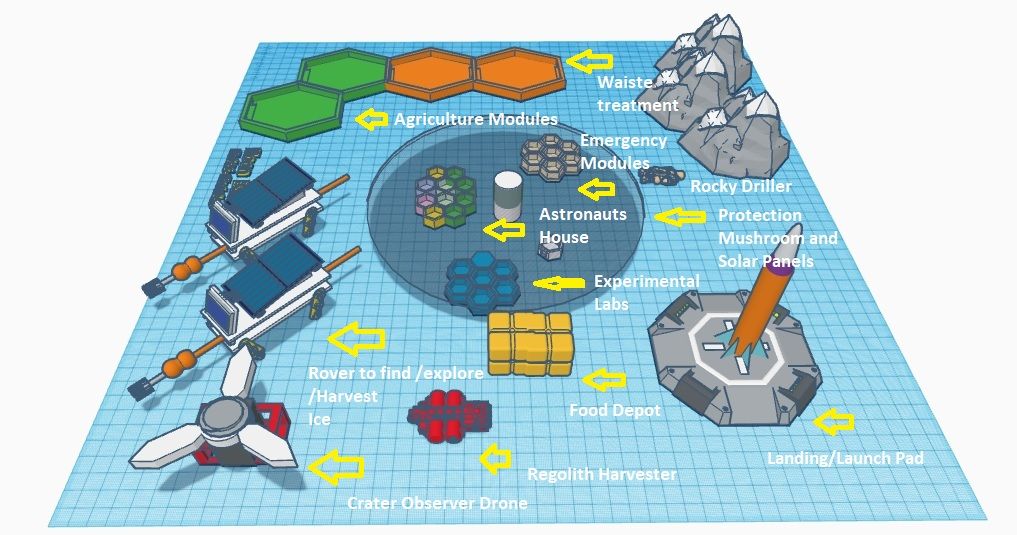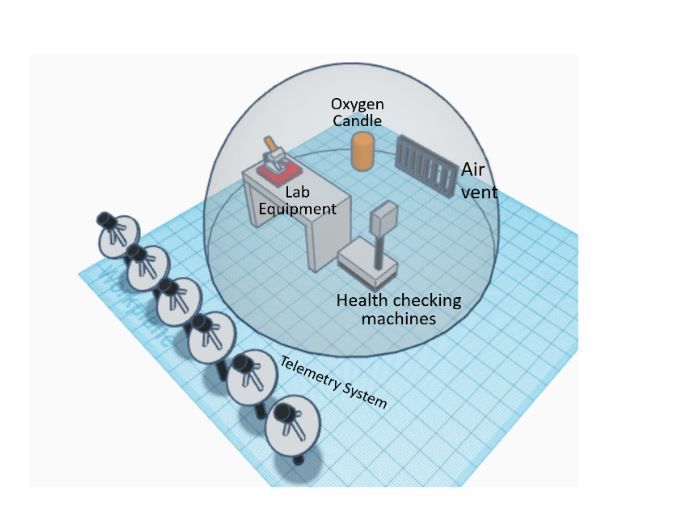Moon Camp Explorers Gallery 2021-2022
In Moon Camp Explorers each team’s mission is to 3D design a complete Moon Camp using Tinkercad. They also have to explain how they will use local resources, protect astronauts from the dangerous of space and describe the living and working facilities.
Team: Herdemann Moon Camp
European School Den Haag Den Haag Netherlands 14 2 / 0
External link for 3d
|
Project description
You have just landed on the Moon. It is a very harsh environment. But you discover that there are some natural resources that you can use on different locations on the lunar surface, such as water ice, regolith (lunar soil) and sunlight .You now have to make some decisions about your Moon Camp. |
||||
|
Where do you want to build your Moon Camp?
Close to the lunar poles Why did you choose this location?
We chose this location because we had to find a compromise between the length of the moon days (not too long, otherwise the energy of the solar panels must be stored for a very long time in the night) and the ability to store water ice under the surface of the moon (to avoid building large tanks). How do you plan to build your Mooncamp? Which materials will you use?
The astronauts and some robots will build the moon camp like this: First, the astronauts will have to dig on the places where the rooms and corridors of the camp will be placed. Then, special balloons made of thick rubber (which are actually the different rooms) will be inflated with air, positioned and anchored. The astronauts will do the same with the corridors and will connect them with the rooms. After that, the 3D-printer will print regolith on the construction to make it more stable and isolate it. The greenhouses will be printed 3D. |
||||
|
Water
|
Food
|
Electricity
|
Air
|
Protection
|
|
Water will first be transported by the capsule. When the astronauts will be settled, they will use the liquid hydrogen from the craters for electrolysis: it makes water in contact with the excess of oxygen produced by the plants. Urine of the astronauts is purified to use as water for the plants. |
The camp has greenhouses where edible plants will be grown. There can also be hold mushrooms to make new earth (compost) of dead plant parts and little animals (like insects) that complete the ecosystem. Human waste is used to feed the plants. |
Many sun panels provide enough energy for keeping the camp rooms on right temperature and let the computers and lightning work. As the sun can regularly disappear for days, we will install a mechanical battery to store the energy. (The battery has weights of regolith. To store energy, the electricity is used to pull up the weights with ropes. To get back the energy, the weights are pulling the rope down and a dynamo converts the movement in electricity.) |
First, air is transported to the moon by the capsule and little quantities of oxygen can also be extracted out of lunar regolith. After the construction of the camp is finished, the air is regularly refreshed by the plants of the greenhouse. |
The 3D-printed regolith gives structure and stability to the inner part of the pods and prevents the airproof ‘shell’ from bursting. The water and hydrogen tanks are very close to the pods to limit the radiation and radiation-protecting materials are used. If the energy of the solar panels is sufficient, there can be an installation in the middle of the camp hosting big magnets making an artificial magnetic field to stop the radiation around the camp. There are also doors between the rooms and the corridors that can be locked to protect the astronauts in case of air loss. |
|
Describe a day on the Moon for one of your Moon Camp astronauts
At 7:00h in the morning, Stanley is woken up by his alarm clock playing “Fly me to the Moon”. After untying his security belts, he has a morning talk with Houston and wakes up the other astronauts. Then he walks through the different rooms of the pods and checks the generators, the food reserves and the pipes and cables. At 9:00, the astronauts take breakfast. Then he checks the day planning. He takes one of the daily tasks: this time, he goes to the greenhouse to take care of the plants and takes some for lunch instead of vacuuming the lab. From 11:00 to 12:00, the astronauts use the sport devices in the lab to maintain themselves fit. After that, they take lunch. During the afternoon, Stanley is occupied by doing experiments in the lab and goes for a trip of 2 hours outside to clean the solar panels and check the lunar vehicle. At 18:00, all the astronauts have dinner. Before going to bed at 20:00, Stanley watches the ‘earth set’ through the big telescope in the observatory. |
||||












